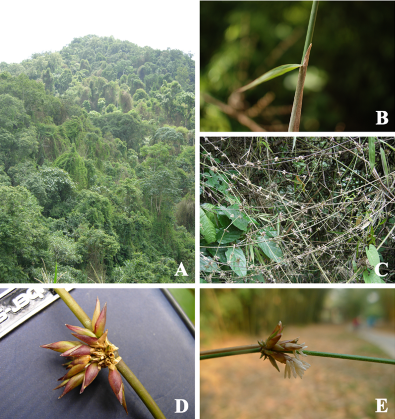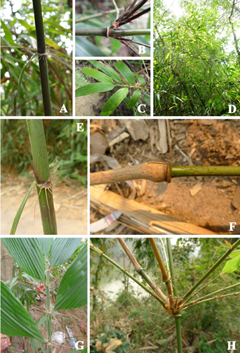Prof. LI Dezhu’s group at the Kunming Institute of Botany, CAS has been focusing on the taxonomy, molecular phylogeny, and biogeography of Asian bamboos for three decades.
Ampelocalamus actinotrichus was described as a species of the genus Arundinaria Michaux when it was published in 1935. This species was found only in Hainan. It was designated as the type species of a new genus Ampelocalamus S. L Chen, T. H. Wen & G. Y. Sheng in 1981. Neomicrocalamus prainii is the type species of the genus Neomicrocalamus P. C. Keng, and it was recorded in southern Tibet and northwestern Yunnan of China and northeastern India (Meghalaya and Nagaland).
In order to confirm the identities of these two species, molecular phylogenetic analyses were carried out. Individuals of Ampelocalamus actinotrichus from Hainan, individuals of Neomicrocalamus prainii from southern Tibet and northwestern Yunnan, and other relevant taxa were included in the analyses.
The phylogenetic analyses indicated that “Ampelocalamus menglaensis” from southern Yunnan had little genetic divergence with individuals of A. actinotrichus from Hainan and they should be conspecific. Furthermore, samples of “teng zhu” from southeastern Yunnan and Neomicrocalamus prainit from southern Tibet and northwestern Yunnan were clustered within the same clade, and “teng zhu” was closer to the individual of N. prainii from Gongshan, northwestern Yunnan. Therefore, “teng zhu” was confirmed to N. prainii.
The distribution of Ampelocalamus actinotrichus provides a case showing floristic affinities of southern Yunnan and Hainan Island in south China at the species level. The disjunct distribution of Neomicrocalamus prainii in Yunnan is concordant with the ecogeographical diagonal line from northwestern Yunnan to southeastern Yunnan.
The northwestern and southeastern Yunnan were once at the same latitude both with a tropical environment. A northward and clockwise rotation of the Shan–Malay Plate (Burma–Malaya Geoblock) made northwestern Yunnan moving toward north and the flora of northwestern Yunnan was replaced by temperate vegetation. This may imply a tropical origin of Neomicrocalamus prainii. The new distribution records of these two species in Yunnan have significance in studying the origin and evolution of Ampelocalamus and Neomicrocalamus.
In addition, the inflorescence of a third climbing bamboo species, Melocalamus yunnanensis (T. H. Wen) T. P. Yi was collected in the field and the Xishuangbanna Tropical Botanical Garden (XTBG) and described for the first time through collaboration with XTBG staff. The features of inflorescence and DNA evidence confirmed the identity of Melocalamus yunnanensis as a member of the genus Melocalamus rather than Racemobambos.
The study has recently been published online in Phytokeys: http://phytokeys.pensoft.net/articles.php?id=7276
This study was supported by National Natural Science Foundation of China (NSFC) (Grant no. 31100148), NSFC-Yunnan Province Joint Research Funds (Grant no. U1136603), and a Doctoral Startup Fund of Northwest A & F University on Molecular Phylogenetics of Ampelocalamus.

Figure 1 Melocalamus yunnanensis. A. Habitat (12153). B. Culm leaf (12153). C. Flowering branches (12154). D–E. Pseudospikelets (D 12154, E C130104). (Image by KIB)

Germplasm Bank of Wild Species
Kunming Institute of Botany, Chinese Academy of Sciences
Dr. ZHANG Yuxiao
Email: zhangyuxiao@mail.kib.ac.cn




